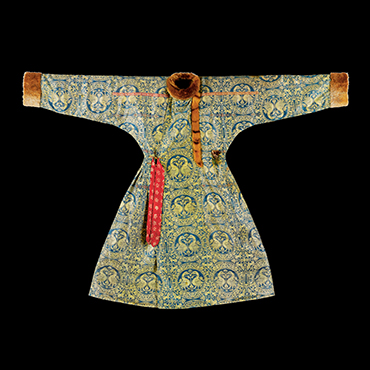Robe of a Seljuk prince
Throughout the medieval Islamic world, precious textiles were highly valued, and their production was sometimes controlled under the authority of the sovereign. Fine silks were an important means of expressing wealth and power, acting as portable wealth among societies of nomadic backgrounds, such as the Seljuks, under whose rule this robe was produced. The Seljuks also adopted the practices of the Abbasid court in Baghdad, where great importance was given to clothing as an aspect of refinement. Bearing a royal inscription, this robe is an exceptional example of the magnificence of medieval princely attire.
The main decoration of two geese facing one another is paralleled in other silk robes from this period, which feature pairs of ducks, cockerels, or falcons. These mirrored birds were drawn from the imagery of pre-Islamic Persia and Central Asia and continued to inspire the silks produced under Mongol rule in the following centuries. A distinctly Islamic aspect to the textile here is provided by the inscriptions. The geese are framed by Arabic text repeating “glory, prosperity, victory”, while a larger band across the upper chest reads “the victorious king, aided by Allah.” These were likely the titles of the ruler for whom this robe was made. The 14th-century historian Ibn Khaldun describes this type of textile inscription, noting that adding rulers’ names to the edges of garments was a display of power and authority, serving as a symbol of dignity reserved for sovereigns.
Figural scenes on contemporary ceramics depict similar robes with bold designs being worn by rulers and their courtiers, some with large birds in a repeat design as seen here. Radiocarbon tests on the material suggest a date of AH 410–555/1020–1160 CE, supporting the art historical dating of this beautiful and important garment.
Robe
Iran or Central Asia, AH 410–555/1020–1160 CE
Silk, cotton, fur, h. 130 × w. 185 cm
The Al Thani Collection, ATC879

